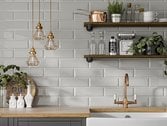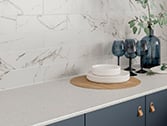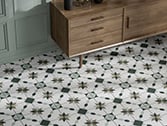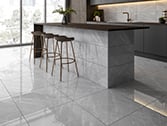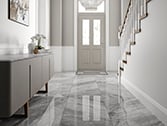How to remove hard water stains from tiles


For those that live in hard water areas, the build-up of limescale happens at a much quicker rate than those in soft water areas. The initial shine can soon be taken away from your tiles if you’re not aware of how to take care of them. We’ve put together our best tips and advice for dealing with water stains and limescale, so read on to find out how to look after your tiles if you’re in a hard water area.
What causes limescale on tiles?
Hard water areas are defined by the water having a higher concentration of dissolved minerals in the water; for example, calcium, magnesium and potassium.
More often found in hard water areas, limescale build up occurs when this type of water evaporates from a surface (particularly in higher temperatures), which leaves behind a layer of build up minerals, known as limescale, in the affected areas.
The longer this layer of mineral debris is left on surfaces, the harder they become to remove; so it’s important to prevent them and clean them in the most effective ways possible. If you haven’t already taken precautions, then you should try to remove the build up as soon as you see it starting to settle.
How to prevent limescale build up on tiles?
If you live in a hard water area and are looking for new tiles, then now is the best time to prevent limescale by choosing the best tiles for hard water. In this case, it is best to avoid natural stone tiles like Travertine, Limestone and Marble.
Naturally, these types of tiles are very porous; thus allowing the minerals from within the hard water more places to settle and stain.
Instead, it may be best to consider glossy and smooth finish tiles, as these are harder for limescale to build up on and easier to wipe clean when build-up appears.
If you are not yet considering a change in tiles, then it may seem obvious, but clean your tiles more regularly. Tile cleaning can be a big job, which is often forgotten. But the more often they are cleaned, the less stubborn the build up will be and cleaning will be quicker and easier to maintain.
We’ve put together a quick guide with the best ways to keep your tiles free from hard water stains and limescale below.
How to remove limescale
Specialist tile cleaners
It’s important to know what material your tiles are made from and what the finish is, as you will then be able to find the products most suitable and effective for your tiles.
For example, the Mattstone Natural Stone Sealer is best suited for any natural or artificial type of stone as it still allows the surface of the tile to breath, whilte still repelling water and protecting against stains. Whereas the LTP Porcelain Tile Sealer is great for polished tiles, as it is an impregnating sealer that does not affect the polished finish of the tile surface. You can find our full selection of Tile Sealers and Cleaners here.
When using professional products like the above, care must be taken not to scuff or scratch the ceramic tiles, so it’s really important to choose the correct specialist products to care for your tiles.
If you need any help with choosing the most suitable specialist products for your own tiles, please get in touch with a member of our team using our contact form or [email protected] and someone will be happy to advise.
Home remedies
For a quick resolution for removing limescale from tiles, there are also some methods that you can try using everyday household cleaning products. These methods are a lot less harsh than using bleach, but still work really well to remove grime and limescale. It’s worth noting however, that these methods are more suitable for ceramic and patterned tiles. As a word of caution, vinegar should never be used on marble tiles.
Try mixing white wine vinegar with either water or baking soda. The acid within the vinegar helps to break down the mineral deposits that build up within hard water stains and limescale, whilst the baking soda helps to dissolve these stains to leave tiles sparkling clean.
When combined, these should form a paste which you can then apply to tiles using either a scouring pad on ceramic tiles, or a softer microfibre cloth or sponge on patterned tiles. There’s no need for scrubbing, just a gentle pressure to apply the paste onto tiles is perfect. After leaving the solution for a while to work its magic, simply rinse off with fresh water and then dry with an old towel.
Cleaning limescale from grout
Unfortunately, hard water stains can appear wherever water is able to settle. So to keep your tiles sparkling clean, you should also focus on keeping grout clean too.
You could use the above mixture and apply with a toothbrush or similar to dissolve down the built up minerals. Really put in some elbow grease here, then leave for around half an hour, before rinsing away the stubborn build up.
If the manual scrubbing option isn’t for you, we also have products specifically designed to keep your grout clean. LTP Grout and Tile Protector Aerosol is a particularly convenient option; simply spray over the area to protect against water, dirt, limescale and more, whilst also making it easier to clean the area in future.







